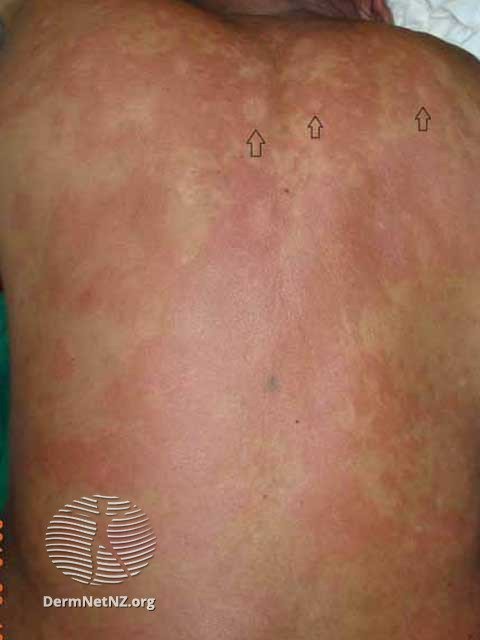
Leprosy (Hansen’s Disease)
An example of leprosy (Hansen’s disease). In this case of borderline leprosy, we see red patches, hypopigmented (lightened) patches, and often will get numbness in the skin.
Credit: DermNet NZ
What is leprosy?
Leprosy is a chronic bacterial infection caused by Mycobacterium leprae or Mycobacterium lepromatosis. The onset of the disease can vary, taking years to manifest after the initial infection. If untreated, leprosy can lead to severe deformities. The manifestation and areas affected by the disease largely hinge on the individual's immune response. Predominantly, leprosy targets the skin, mucous membranes, nerves, eyes, and testicles, leading to a reduced or total loss of pain sensation.
What causes leprosy?
Leprosy is triggered by the bacteria Mycobacterium leprae or Mycobacterium lepromatosis. Not everyone infected with these bacteria develops leprosy, and the reasons for this remain ambiguous. Direct contact with a person carrying leprosy presents the highest risk of transmission. Additionally, in the USA, armadillos have been identified as carriers. Other risk factors encompass:
Malnutrition
Residing in tropical or subtropical climates
Living in impoverished conditions
Being in areas with a high prevalence of leprosy such as India, Indonesia, Myanmar, Brazil, and Nigeria
What are the symptoms of leprosy?
Symptoms of leprosy typically manifest 2-3 years post-infection but can range anywhere from 6 months to over 40 years. Early signs often include numbness in extremities, specifically fingers and toes. The progression usually starts with the inability to detect temperature changes, followed by impaired tactile sensations, and then a loss of pain and deep pressure sensations. Dermatological symptoms ensue, including:
Dry, hairless patches of pale or pink skin that lack temperature or pain sensitivity
Various skin lesions ranging in size and shape
Smooth, shiny skin thickening, especially on the face, ears, or hands
Nasal congestion, discharge, and bleeding
Muscle weakness, vision issues, and a hoarse voice
How is leprosy treated?
The primary treatment approach for leprosy is multidrug therapy utilizing specific antibiotics. After a month of consistent treatment, patients are typically no longer infectious. However, medication might be needed for an extended period, spanning months to years. The principal antibiotics administered are dapsone, rifampicin, and clofazimine. Supplementary medications such as minocycline, ofloxacin, clarithromycin, oral steroids, and thalidomide might also be prescribed. Some patients experience immune reactions during treatment, which can be managed with additional medications.
Nerve damage resulting from leprosy can sometimes be reversible if detected and treated promptly. Nevertheless, any delay in treatment, spanning several months, could result in permanent nerve damage. Completing the prescribed course of antibiotics is imperative. Additionally, protecting the numbed areas from potential injuries is crucial.
How can leprosy be prevented?
For individuals in close contact with leprosy patients, preventive medications can be administered. A single dose of rifampicin can cut the risk of contracting leprosy by over half. Additionally, the Bacillus Calmette–Guérin (BCG) vaccine, initially designed for Tuberculosis, has shown efficacy in reducing the risk of leprosy.
Classic lepromatous leprosy which causes a distinct “leonine” appearance to the face.
Credit: DermNet NZ
In skin of color, the hypopigmented variant may be easier to appreciate.
Credit: DermNet NZ



